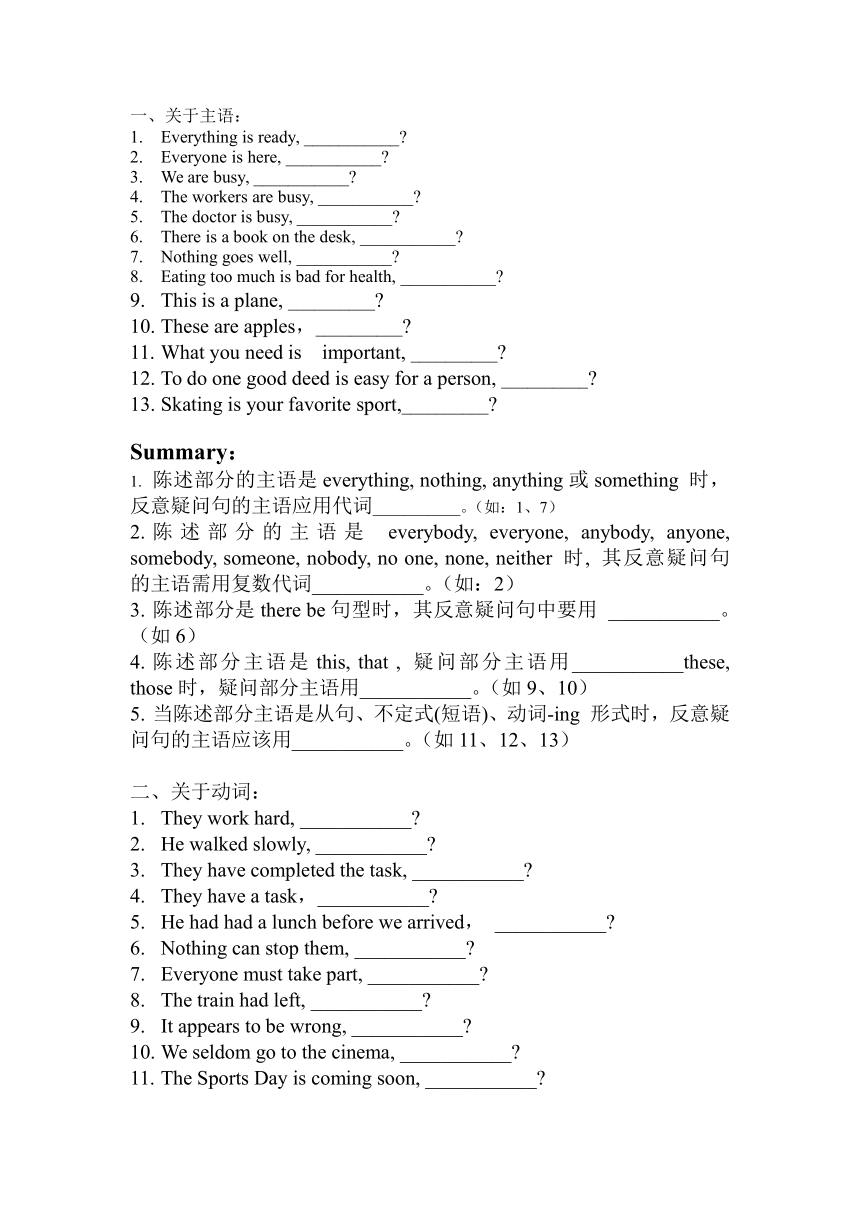人教版(2019)必修 第一册Unit 3 Sports and fitness 反义疑问句学案(无答案)
文档属性
| 名称 | 人教版(2019)必修 第一册Unit 3 Sports and fitness 反义疑问句学案(无答案) |

|
|
| 格式 | zip | ||
| 文件大小 | 20.6KB | ||
| 资源类型 | 教案 | ||
| 版本资源 | 人教版(2019) | ||
| 科目 | 英语 | ||
| 更新时间 | 2021-11-23 13:01:41 | ||
图片预览

文档简介
一、关于主语:
Everything is ready, ___________
Everyone is here, ___________
We are busy, ___________
The workers are busy, ___________
The doctor is busy, ___________
There is a book on the desk, ___________
Nothing goes well, ___________
Eating too much is bad for health, ___________
This is a plane, __________
These are apples,__________
What you need is important, __________
To do one good deed is easy for a person, __________
Skating is your favorite sport,__________
Summary:
陈述部分的主语是everything, nothing, anything或something 时,反意疑问句的主语应用代词___________。(如:1、7)
陈述部分的主语是 everybody, everyone, anybody, anyone, somebody, someone, nobody, no one, none, neither 时, 其反意疑问句的主语需用复数代词___________。(如:2)
陈述部分是there be句型时,其反意疑问句中要用 ___________。(如6)
陈述部分主语是this, that , 疑问部分主语用___________these, those时,疑问部分主语用___________。(如9、10)
当陈述部分主语是从句、不定式(短语)、动词-ing 形式时,反意疑问句的主语应该用___________。(如11、12、13)
二、关于动词:
They work hard, ___________
He walked slowly, ___________
They have completed the task, ___________
They have a task,___________
He had had a lunch before we arrived, ___________
Nothing can stop them, ___________
Everyone must take part, ___________
The train had left, ___________
It appears to be wrong, ___________
We seldom go to the cinema, ___________
The Sports Day is coming soon, ___________
Summary:
当have、has、had意为“拥有”时,反义疑问句要借用助动词:do 、does、did。
当have、has、had作系动词时,反义疑问句直接用have、has、had的相应形式。(如3、4、5)
当陈述部分含有情态动词must时,如must 作“一定;要;必须”讲,反意疑问句用___________;而must表推测意义“一定是;必定”时,反意疑问句则需根据must后的动词原形选用相应的形式。
常见的特殊情况:
Give me a hand, ___________
Leave all the things as they are, ___________
Let us know the time of your arrival, ___________
Let's try again,___________
You'd better read it by yourself, ___________
You'd better not stay here, ___________
He used to take pictures there, ___________
The old man used to get up early, ___________
I think that he has done his best, __________
He said he wanted to visit Japan, ____________
Summary:
祈使句:祈使句的反义疑问句不区分肯定句还是否定句,为___________。
但以 let’s 开头的用___________。
2、含情态动词had better, 反义疑问句的动词要用___________。
3、陈述部分用 used to +动词原形时,问句部分用___________或___________形式。
4、宾语从句中,以主句为准;但如果主语是第一人称且谓语动词是think, believe, guess, suppose 时,以从句为准。
回答:
1.前否后肯要根据事实来回答,事实是肯定的用Yes.事实是否定的用No.
2.前否后肯的Yes译为“不”,No译为“是的”。
1.You aren’t a teacher, are you 你不是老师,是吗?
Yes, I am.___________/ No, I’m not.___________
You aren’t asleep, are you
Yes, I am.___________/ No, I’m not.___________
3.It’s going to rain,isn’t it
Yes, it is.___________/ No, it isn’t___________
4.It’s not going to rain,is it
Yes, it is.___________/ No, it isn’t___________
Everything is ready, ___________
Everyone is here, ___________
We are busy, ___________
The workers are busy, ___________
The doctor is busy, ___________
There is a book on the desk, ___________
Nothing goes well, ___________
Eating too much is bad for health, ___________
This is a plane, __________
These are apples,__________
What you need is important, __________
To do one good deed is easy for a person, __________
Skating is your favorite sport,__________
Summary:
陈述部分的主语是everything, nothing, anything或something 时,反意疑问句的主语应用代词___________。(如:1、7)
陈述部分的主语是 everybody, everyone, anybody, anyone, somebody, someone, nobody, no one, none, neither 时, 其反意疑问句的主语需用复数代词___________。(如:2)
陈述部分是there be句型时,其反意疑问句中要用 ___________。(如6)
陈述部分主语是this, that , 疑问部分主语用___________these, those时,疑问部分主语用___________。(如9、10)
当陈述部分主语是从句、不定式(短语)、动词-ing 形式时,反意疑问句的主语应该用___________。(如11、12、13)
二、关于动词:
They work hard, ___________
He walked slowly, ___________
They have completed the task, ___________
They have a task,___________
He had had a lunch before we arrived, ___________
Nothing can stop them, ___________
Everyone must take part, ___________
The train had left, ___________
It appears to be wrong, ___________
We seldom go to the cinema, ___________
The Sports Day is coming soon, ___________
Summary:
当have、has、had意为“拥有”时,反义疑问句要借用助动词:do 、does、did。
当have、has、had作系动词时,反义疑问句直接用have、has、had的相应形式。(如3、4、5)
当陈述部分含有情态动词must时,如must 作“一定;要;必须”讲,反意疑问句用___________;而must表推测意义“一定是;必定”时,反意疑问句则需根据must后的动词原形选用相应的形式。
常见的特殊情况:
Give me a hand, ___________
Leave all the things as they are, ___________
Let us know the time of your arrival, ___________
Let's try again,___________
You'd better read it by yourself, ___________
You'd better not stay here, ___________
He used to take pictures there, ___________
The old man used to get up early, ___________
I think that he has done his best, __________
He said he wanted to visit Japan, ____________
Summary:
祈使句:祈使句的反义疑问句不区分肯定句还是否定句,为___________。
但以 let’s 开头的用___________。
2、含情态动词had better, 反义疑问句的动词要用___________。
3、陈述部分用 used to +动词原形时,问句部分用___________或___________形式。
4、宾语从句中,以主句为准;但如果主语是第一人称且谓语动词是think, believe, guess, suppose 时,以从句为准。
回答:
1.前否后肯要根据事实来回答,事实是肯定的用Yes.事实是否定的用No.
2.前否后肯的Yes译为“不”,No译为“是的”。
1.You aren’t a teacher, are you 你不是老师,是吗?
Yes, I am.___________/ No, I’m not.___________
You aren’t asleep, are you
Yes, I am.___________/ No, I’m not.___________
3.It’s going to rain,isn’t it
Yes, it is.___________/ No, it isn’t___________
4.It’s not going to rain,is it
Yes, it is.___________/ No, it isn’t___________
